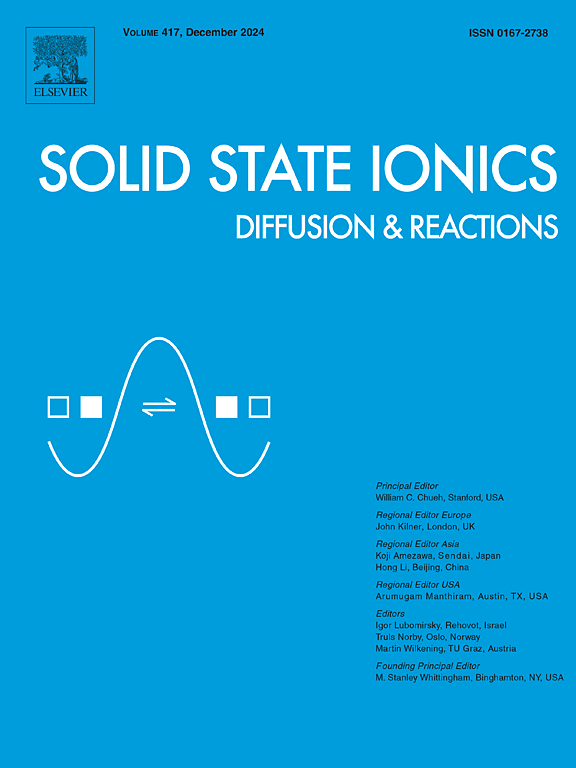Synthesis and electrochemical performance enhancement of Li2MnSiO4 cathode material for lithium-ion batteries via Mn-site Cr doping
IF 3.3
4区 材料科学
Q3 CHEMISTRY, PHYSICAL
引用次数: 0
Abstract
Li2MnSiO4 stands out as a promising cathode material for lithium-ion batteries (LIBs) because of its remarkable theoretical capacity, excellent thermal stability, low cost, and environmental benefits. However, its practical application is hindered by poor electronic conductivity and lithium-ion diffusion rates. To overcome these challenges, Li2Mn1-xCrxSiO4 cathode materials were prepared through solid-state doping and a two-step calcination method. By doping Cr into the Mn site of Li2MnSiO4, the electrochemical performance can be significantly improved. TG-DTA tests were conducted to determine the optimal calcination temperature to ensure stable synthesis of the material. The research found that an optimal Cr doping level of 0.06 resulted in superior electrochemical performance, achieving a discharge capacity of 174.9 mAh g−1 at 0.1C. This improvement is due to the reduction in grain size, which increases the specific surface area and enhances Li+ diffusion. Additionally, the larger ionic radius of Cr creates more vacancies in the lattice, facilitating electron and ion migration. The Cr![]() O bond, being stronger than the Mn
O bond, being stronger than the Mn![]() O bond, further contributes to improved structural stability. Thus, Cr doping effectively addresses conductivity and diffusion limitations, leading to superior electrochemical performance and advancing high-performance LIBs.
O bond, further contributes to improved structural stability. Thus, Cr doping effectively addresses conductivity and diffusion limitations, leading to superior electrochemical performance and advancing high-performance LIBs.
锰位铬掺杂锂离子电池正极材料Li2MnSiO4的合成及电化学性能增强
Li2MnSiO4因其卓越的理论容量、优异的热稳定性、低成本和环境效益而成为锂离子电池(LIBs)极具前景的正极材料。然而,它的实际应用受到电子导电性差和锂离子扩散速率的阻碍。为了克服这些挑战,采用固态掺杂和两步煅烧法制备了Li2Mn1-xCrxSiO4正极材料。通过在Li2MnSiO4的Mn位点掺杂Cr,可以显著提高其电化学性能。通过TG-DTA试验确定了稳定合成材料的最佳煅烧温度。研究发现,当Cr掺杂量为0.06时,电池的电化学性能优异,在0.1C下的放电容量可达174.9 mAh g−1。这种改善是由于晶粒尺寸的减小,增加了比表面积,增强了Li+的扩散。此外,较大的离子半径会在晶格中产生更多的空位,从而促进电子和离子的迁移。CrO键比MnO键更强,进一步提高了结构的稳定性。因此,Cr掺杂有效地解决了电导率和扩散的限制,导致了优异的电化学性能和高性能lib的发展。
本文章由计算机程序翻译,如有差异,请以英文原文为准。
求助全文
约1分钟内获得全文
求助全文
来源期刊

Solid State Ionics
物理-物理:凝聚态物理
CiteScore
6.10
自引率
3.10%
发文量
152
审稿时长
58 days
期刊介绍:
This interdisciplinary journal is devoted to the physics, chemistry and materials science of diffusion, mass transport, and reactivity of solids. The major part of each issue is devoted to articles on:
(i) physics and chemistry of defects in solids;
(ii) reactions in and on solids, e.g. intercalation, corrosion, oxidation, sintering;
(iii) ion transport measurements, mechanisms and theory;
(iv) solid state electrochemistry;
(v) ionically-electronically mixed conducting solids.
Related technological applications are also included, provided their characteristics are interpreted in terms of the basic solid state properties.
Review papers and relevant symposium proceedings are welcome.
 求助内容:
求助内容: 应助结果提醒方式:
应助结果提醒方式:


